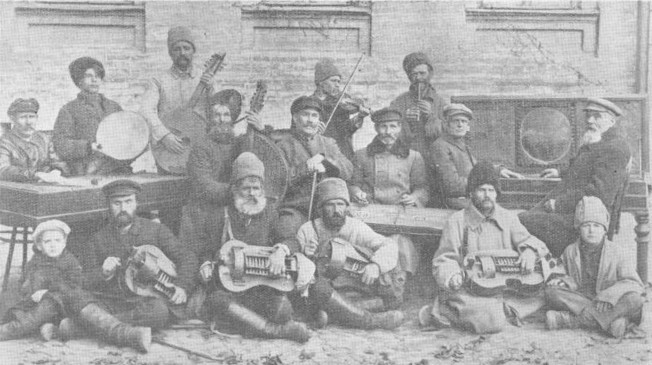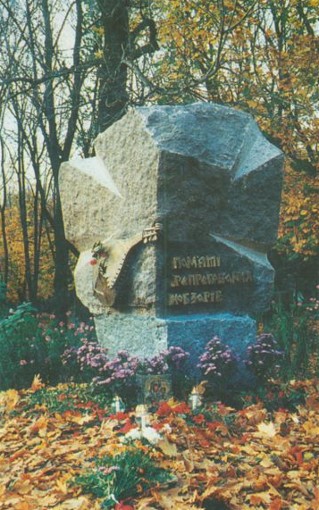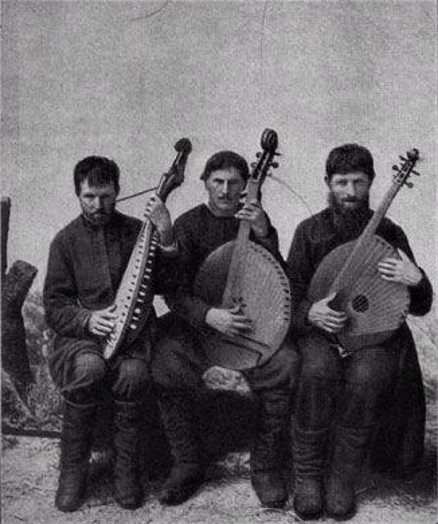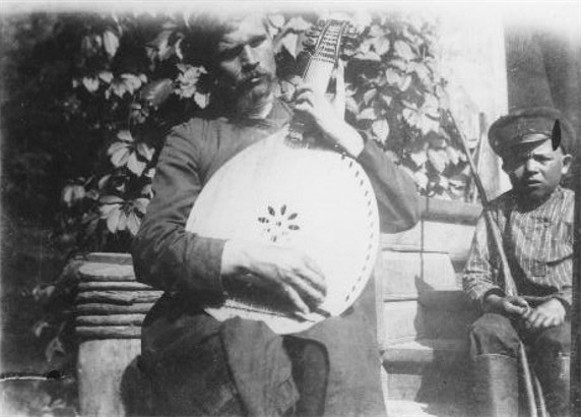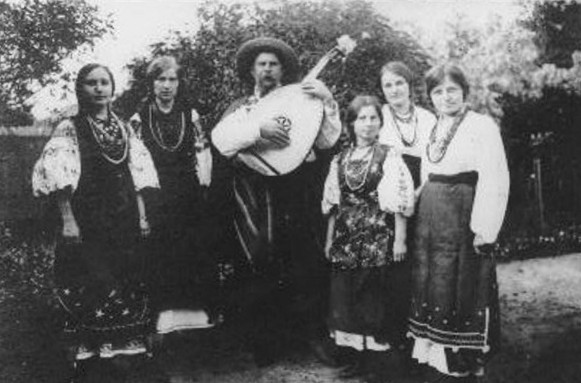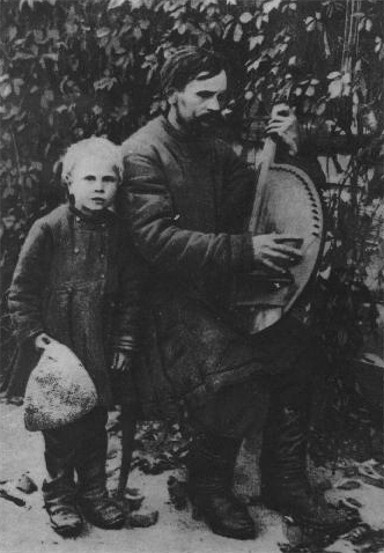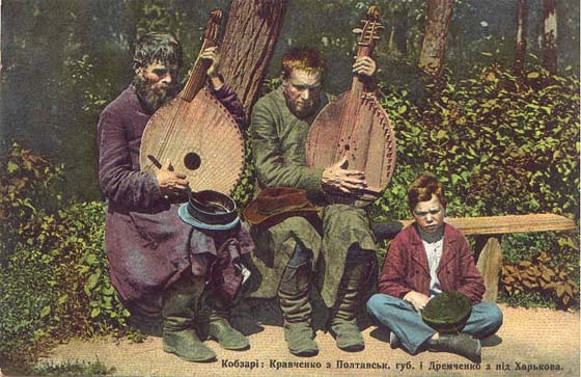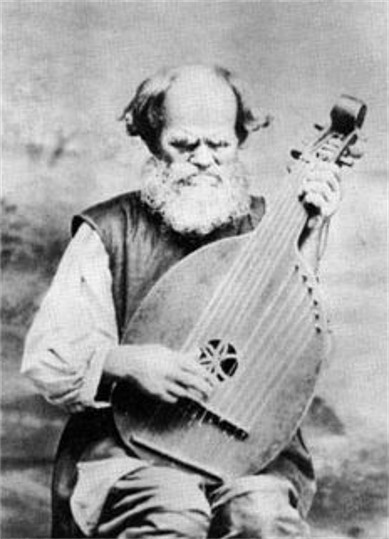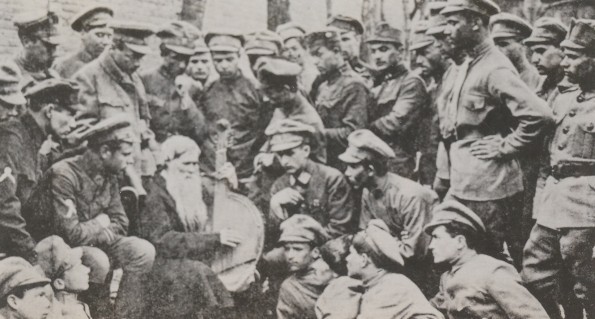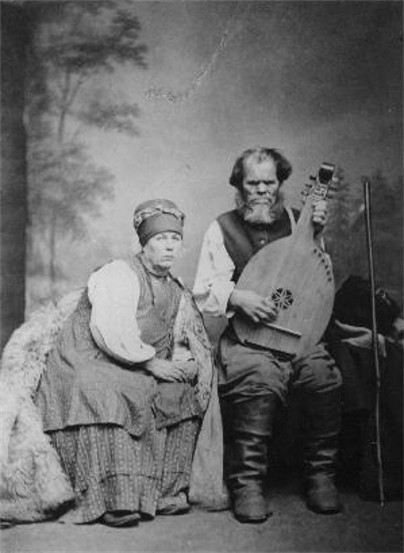Kobzars
Kobzars (кобзарі; kobzari). Wandering folk bards who performed a large repertoire of epic-historical, religious, and folk songs while playing a kobza or bandura. Kobzars first emerged in Kyivan Rus’ and were popular by the 15th century. Some (eg, Churylo and Tarashko) performed at Polish royal courts. They lived at the Zaporozhian Sich and were esteemed by the Cossacks, whom they frequently accompanied on various campaigns against the Turks, Tatars, and Poles. The epic songs they performed served to raise the morale of the Cossack army in times of war, and some (eg, Prokip Skriaha, Vasyl Varchenko, and Mykhailo, ‘Sokovy's son-in-law’) were even beheaded by the Poles for performing dumas that incited popular revolts.
As the Hetman state declined, so did the fortunes of the kobzars, and they gradually joined the ranks of mendicants, playing and begging for alms at rural marketplaces. In the late 18th century the occupation of kobzar became the almost exclusive province of the blind and crippled, who organized kobzar brotherhoods to protect their corporate interests. A few performed at the Russian courts of Peter I, Elizabeth I, and Catherine II (eg, Hryhorii Liubystok and O. Rozumovsky). In the 19th and 20th centuries, particularly from the 1870s, the kobzars, including the virtuosos Ostap Veresai and Hnat Honcharenko, were persecuted by the tsarist regime as the propagators of Ukrainophile sentiments and historical memory. (Kobzars are immortalized in the poetry and drawings of Taras Shevchenko and he titled his poetic works Kobzar.) The few hundred remaining kobzars in Poltava gubernia, Kharkiv gubernia, and Chernihiv gubernia and their artistry aroused the interest of various ethnographers, composers, and painters, including Mykola Lysenko, Oleksander Rusov, Opanas Slastion, Lesia Ukrainka, Klyment Kvitka, Mykola Sumtsov, Vasyl Horlenko, Valeriian Borzhkovsky, O. Borodai, Filaret Kolessa, and Dmytro Revutsky. At the 12th Russian Archeological Congress in Kharkiv in 1902, the kobzars Terentii Parkhomenko, H. Honcharenko, Mykhailo Kravchenko, Ivan Kucherenko-Kuchuhura, P. Hashchenko, P. Drevchenko, and I. Netesa, accompanied by Hnat Khotkevych, the ‘first seeing kobzar’ (he composed 69 works for the bandura) and the leading authority on kobzar artistry, performed to great acclaim, and the congress participants passed a resolution concerning the great value of the kobzars' art. Government attitudes toward the kobzars softened, and thereafter kobzar concerts became frequent events in many Ukrainian and Russian cities. Bandura schools were established, and in 1907 Khotkevych published the first history and manual of bandura playing; V. Shevchenko's and V. Ovchynnykov's manuals followed in 1914.
After the Revolution of 1905 the kobzars again flourished. From 1908 bandura playing was taught at the Lysenko Music and Drama School in Kyiv. The kobzar artistry spread into the Kuban, where it had not existed before. The Kuban kobzars A. Chorny, V. Liashchenko, and D. Darnopykh became famous, and the bandura was introduced into the military orchestras of the Kuban Cossack Host. During the Revolution of 1917 and subsequent Ukrainian-Soviet War, 1917–21, kobzars composed and performed songs promoting the Ukrainian national cause and smuggled political literature; many paid for this with their lives. From July 1918 to 1919 the first Ukrainian banduryst ensemble existed briefly in Kyiv.
Under Soviet rule, the State Banduryst Kapelle of Ukraine was established in Kyiv in 1927. The Ethnographic Commission of the All-Ukrainian Academy of Sciences and VUAN Cabinet of Musical Ethnography, particularly the members Klyment Kvitka, Mariia Hrinchenko, and Kateryna Hrushevska, conducted important studies of the kobzars in the 1920s. In 1929 Hryhorii Epik published the novel Zustrich (The Meeting) depicting the persecution of the kobzars. In the 1930s, with forced collectivization, the Famine-Genocide of 1932–3, and the Stalinist suppression of Ukrainian culture, the kobzars were again repressed. Party directives to create a new socialist folklore and ‘Soviet’ kobzars resulted in the First Republican Conference of Kobzars and Lirnyks in April 1939, sponsored by the Institute of Fine Arts, Folklore, and Ethnography of the Academy of Sciences of the Ukrainian SSR. Thirty-seven kobzars, including Petro Huz, F. Kushneryk, Yehor Movchan, Pavlo Nosach, Oleksander A. Markevych, Ye. Adamtsevych, S. Avramenko, and Volodymyr Perepeliuk, were brought together to discuss ‘the first examples of Soviet dumas and heroic songs and the task of creating a Soviet epos.’ A number of such examples (eg, ‘Duma about the Communist Party,’ ‘Duma about Lenin’) were composed with the institute's workers and members of the Writers' Union of Ukraine and Union of Composers of Ukraine and performed at the conference's closing concert. The ‘creators’ were immediately inducted into the writers' union, and a Section of Folk Arts was formed in the union to ‘organize systematic creative and methodological assistance for kobzars and lirnyks.’ Yet, as composer Dmitri Shostakovich testifies in his memoirs (Testimony, 1979), several hundred kobzars and lirnyks were brought to the congress from all parts of Ukraine and after the congress ended almost all of them were shot.
To hide this tragedy, the Institute of Fine Arts, Folklore, and Ethnography of the Academy of Sciences of the Ukrainian SSR and the Kyiv Philharmonic jointly set up a State Ethnographic Kobzar Ensemble in early 1941, consisting of Yehor Movchan, Pavlo Nosach, Petro Huz, Oleksander A. Markevych, Volodymyr Perepeliuk, and I. Ivanchenko; M. Hrinchenko was appointed artistic director. During its brief existence, the ensemble performed throughout Ukraine and in Moscow until the German invasion of the Soviet Union in June 1941.
During the Second World War, kobzars fought in the Red Army and various Soviet partisan units (see Soviet partisans in Ukraine, 1941–5) (eg, O. Chupryna, S. Vlasko, D. Vovk, A. Bilotsky) and composed military-patriot songs. Since the war, many professional bandurysts (eg, Fedir Zharko, Volodymyr Perepeliuk, and A. Hryshyn) have supplemented the folk kobzars. Bandura playing has been widely taught, and many amateur and professional ensembles have been created. In 1969 a large kobzar concert took place in Kyiv and the Alliance of Folk Bards-Kobzars was formed under the auspices of the Music Society of the Ukrainian SSR. In 1974 the alliance was transformed into a Section of Kobzars and Bandurysts, with professionaland amateur members. In 1975 an artistic council of bandurysts was formed from among its members.
Kobzar artistry has been cultivated among Ukrainians in the West, thanks to the efforts of Vasyl Yemets, J. and Hryhorii Kytasty, P. Honcharenko, V. Kachurak, Zinovii Shtokalko, Roman Levytsky, Volodymyr Lutsiv, Victor Mishalow, and other masters. Various banduryst ensembles exist in many countries in Europe and North America. In New York, Detroit, Chicago, and Toronto, there are bandura schools. Since 1982 the school in New York has published the journal Bandura. In Poland, kobzar artistry has successfully been propagated among Ukrainians through the efforts of A. Khraniuk. In Slovakia, there has been a group of female bandurysts within the Duklia Ukrainian Folk Ensemble in Prešov.
BIBLIOGRAPHY
Speranskii, M. Iuzhnorusskaia pesnia i sovremennye ee nositeli (po povodu bandurista T.M. Parkhomenko) (Kyiv 1904)
Iemets’, V. Kobza ta kobzari (Berlin 1922)
Kyrdan, B.; Omel’chenko, A. Narodni spivtsi-muzykanty na Ukraïni (Kyiv 1980)
Lavrov, F. Kobzari: Narysy z istoriï kobzarstva Ukraïny (Kyiv 1980)
Shtokalko, Zinovii. Kobzars’kii pidruchnyk (Edmonton–Kyiv 1992)
Noll, V. ‘Moral’nyi avtorytet ta suspil’na rol’ slipykh bardiv v Ukraïni,’ Rodovid, 6 (1993)
Kononenko, N. Ukrainian Minstrels ... and the blind shall sing (Armonk, NY 1998)
Mykola Mushynka
[This article originally appeared in the Encyclopedia of Ukraine, vol. 2 (1988). The bibliography has been updated.]

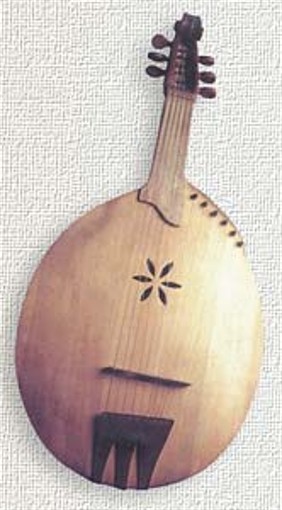
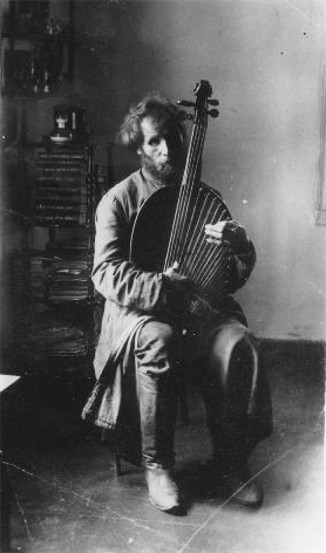
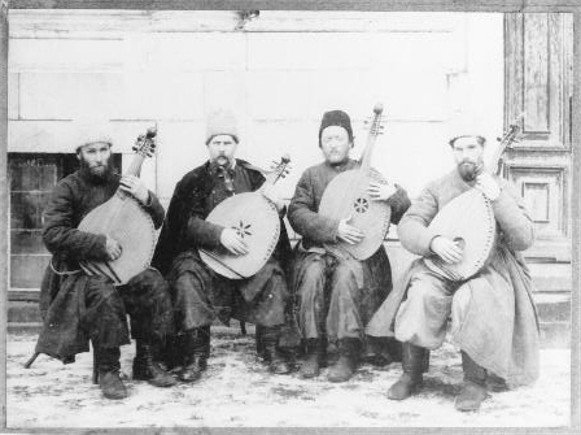
.jpg)
